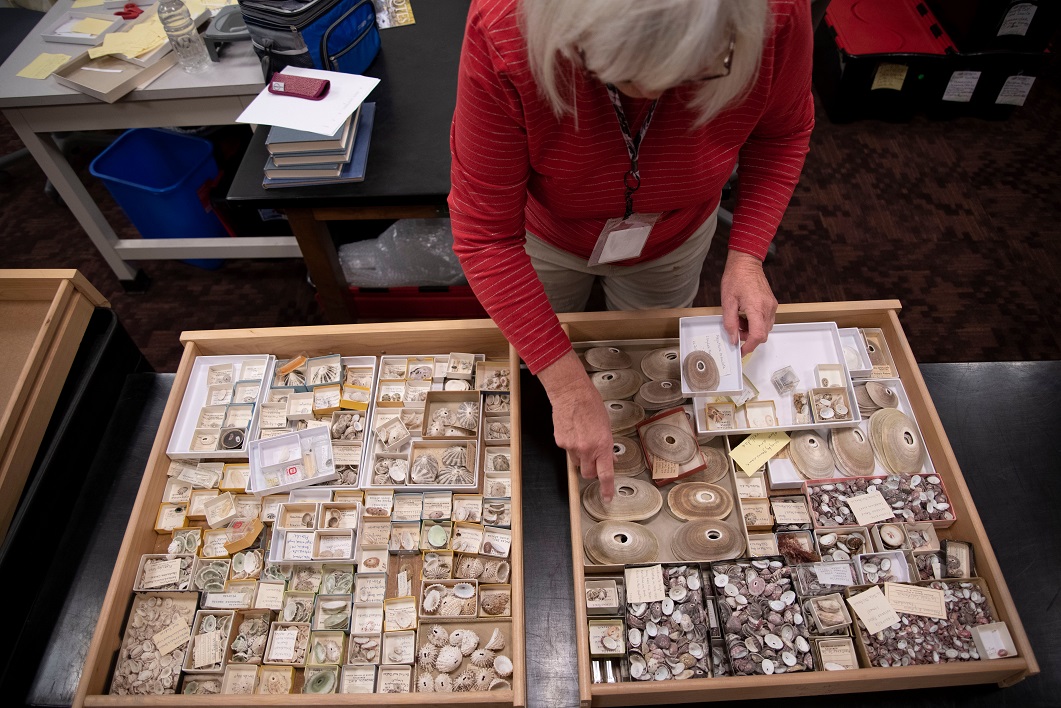Volunteers explore passions at rapidly growing ASU Natural History Collections facility

Volunteers Ruth Kearns and Albert Thurman volunteer their time cataloging insect species. They are part of the 15 volunteers who come in weekly to help keep the collections in order. Photo by Samantha Lloyd/ASU VisLab
Dale Snyder discovered her love of seashells while living on isolated beaches as a Navy wife in the 1970s.
In retirement, she has become a self-taught conchologist, learning about the diversity and ecology of mollusks in both her own collection and the collections that she volunteers to catalog for the Arizona State University Natural History Collections.
“I’m pretty much self-taught. You don’t really see courses in conchology,” Snyder said. “A lot of times, two shells will be completely identical. I just about broke my brain working on some of the limpets, trying to figure out what the differences were.”
She’s one of 15 volunteers who work at the facility on a weekly basis, scouring the internet and books to identify species in various collections. Many of the volunteers are seniors with an interest in a particular collection, like Snyder, but the age range of volunteers spans from 19 to 89.
“It’s easier to fill this space with stuff than with people,” said Nico Franz, ASU School of Life Sciences professor and founder of the Biodiversity Knowledge Integration Center. “For people to come down here, they have to have a reason more important than something else they’re already doing.”
Increased need for volunteers
Franz needs the assistance. The National Ecological Observatory Network (NEON) named ASU as the primary host of its national biorepository for the next 30 years, which means that the collections facility receives up to five shipments of specimens each day.
The specimens come in all forms: soil samples, mosquito diseases, pinned ground beetles, mammal fecal samples, DNA samples, vertebrate tissue and plant tissue. As Franz points out, the boxes are piling up.
To keep up with the influx of biospecimens, the staff has doubled in less than a year, growing from four collections managers to seven and adding an additional two people to update databases. Another new project manager helps with internal and external communication and outreach.
The new employees are expected to wear many hats. In addition to managing day-to-day operations, they work with researchers at other universities who want to utilize the collections.
They teach classes and conduct outreach. Herbarium collections manager Liz Makings instructs a class on Sonoran Desert ecology that is so popular, they may offer more sections.
And, they even conduct their own research. For example, insect collections manager Sangmi Lee works with the United States Department of Agriculture to identify invasive plants and learn about their life history traits to slow their expansion.

Dale Snyder, Arizona State University Natural History Collections volunteer, sorts through a collection of mollusks that has been donated to the university. Many volunteers, like Snyder, begin volunteering because they would like to learn more about cataloging their own collections. Photo by Samantha Lloyd/ASU VisLab
Exploring passions
Volunteers also must fill many roles.
“They are organizing. They give time, expertise, specimens and in some cases, money,” Franz said. “Very often, they contribute to our outreach program, so they become instructors or teachers or leaders for public outreach events, and those can be tailored to engage students in K-12 to lifelong learners. Volunteers do most everything for us.”
However, they aren’t easy to find. Most learn about volunteer opportunities through word-of-mouth. Snyder was looking for help on her own collection in 2012 and contacted Franz, who, in turn, requested her help.
“When he called back, he said, 'We have a large collection and it’s in terrible shape, but you’re welcome to come look at it,'” Snyder said. “Then he told me, 'If you want to do anything with it, you’re welcome to.' I thought, I love them so much. I just have to work on them.”
She’s been working on the collection for six years now and can speak about weather patterns that affected the range of certain mollusks along the coast of Mexico and describe how climate change is affecting species in California.
A love of insects
Another senior volunteer, Ruth Kearns, has a similar level of expertise on the insect collections.
Kearns earned her PhD in entomology years ago but never had an opportunity to pursue a career studying insects. When she heard about the collection facility, she had just one question: When can I be there?
“I’m from the generation where you followed what your husband did and figured out what to do there, and I liked to teach so I taught all different grades from K–12 in Delaware,” Kearns said. “But of course, what I really cared about was insects. I decided in retirement, it would be nice to get back into the profession, even if I couldn’t get a paid position.” She’s been volunteering for 10 years.
Growing a volunteer pool
As the facility grows, Franz would like to see more volunteers get involved.
He is currently working with an architect to expand the building and make room for a liquid nitrogen collection that must be kept at -190 degrees Celsius and an additional 25-30 special freezers for the cryo-collection.
In addition to receiving upwards of 100,000 samples from NEON to the facility annually, the collections group hopes to attract externally funded research teams use the samples and collections facilities. Thus, Franz would like to build a shared molecular research space where scientists from other universities can work with the extensive sample collection.
The expansion would also provide training space, room for classes and more opportunities for volunteers.
More Science and technology

ASU student-run podcast shares personal stories from the lives of scientists
Everyone has a story.Some are inspirational. Others are cautionary. But most are narratives of a person’s path, sometimes a…

The meteorite effect
By Bret HovellEditor's note: This story is featured in the winter 2025 issue of ASU Thrive.On Nov. 9, 1923, Harvey Nininger saw…

Why your living environment defines how people perceive you
Stereotypes are pervasive.We've all heard of stereotypes based on gender, race, age or religion. But what about making an…